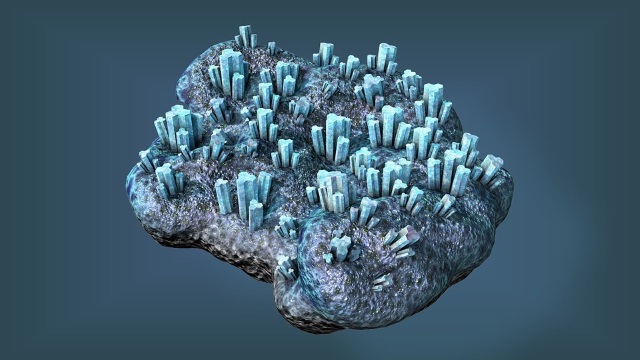[wp_ad_camp_2]
How to make a basic crystal out of Potash Alum.
Growing crystals takes a bit of time, but it’s a really fun project. You never know what you’ll get until you try it. We have several crystal growing projects planned for you on the site, but here is the first. It isn’t to difficult and the results are pretty fun … so enjoy!
Required materials for this project include:
- Potash Alum
- A piece of string or thread
- Saucepan (for safety reasons, please use a saucepan that you will never cook food in again. Keep it for making more crystals or simply throw it away.)
- A saucer
- A pencil
- A jar
Growing your crystal will take about 2 to 3 weeks. It’s a waiting process so be patient and be sure to note what you see periodically (a daily photo log is great for this).
Directions:
- Pour 1 pint of water into the saucepan.
- Add 4oz. of alum powder.
- Gently heat the mixture; stirring to dissolve the powder.
- After the initial powder dissolves, begin adding as much powder to the mixture that you can until no more powder will dissolve.
- After letting the mixture cool, pour some into the saucer and set the saucer in a cool place.
- Pour the rest of the solution into a glass jar and add 1 more tablespoonful of the alum powder to create a saturated mixture.
- Cover the jar with a cloth and set it aside for now.
- After a few days, the solution in the saucer should start to form crystals. Let them grow undisturbed in the saucer until the solution has evaporated.
- Choose the largest crystal from among those in the saucer. This crystal will be your “seed”.
- Carefully tie your string or thread around your seed crystal and then wind the rest of the length of thread around the pencil.
- Hang the seed crystal into the jar of solution letting the pencil sit across the top of the jar to hold the seed in place within the solution.
- Put the jar in a warm place and leave it completely alone for about 2 weeks. Your crystal will grow from that “seed” over this time period.
So what did you find?
Record your results. Again, a photo log is a great way to do this. You should take photos of the original liquid in the saucer, then document the growth of the seed crystals, tying the string around the seed, the initial seed+string in the jar of the saturated solution and a daily picture of what that jar/string looks like.
Once you’ve done that, the report your teacher will probably ask for will be quite easy to write!
Then, if you want to get fancy, note that different powders will yield different colored crystals. But you’ll need to experiment a bit on the amount of water and powder needed for each recipe to get a saturated solution for each.
As examples (not a complete list for sure):
– Potassium Ferricyanide will produce red crystals.
– Copper Acetate Monohydrate will produce blue-green crystals.
– Calcium Copper Acetate Hexahydrate will produce blue crystals.
Try all of them and have fun!
You can also grow crystals with sugar and these will be delicious edible ones if you do it correctly.
… But if you would rather have pre-packaged materials for crystal growing, these should help:
… and if you prefer to discover them yourselves, these should help:
And for really “Big” Crystal hunters, you might want to take a look at curiosity stream:






